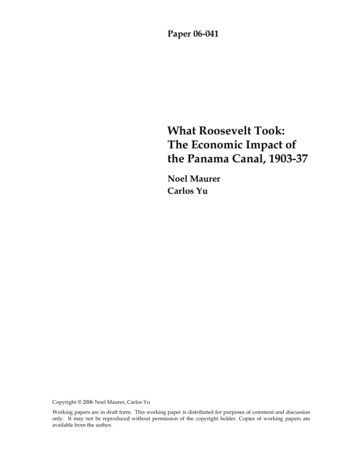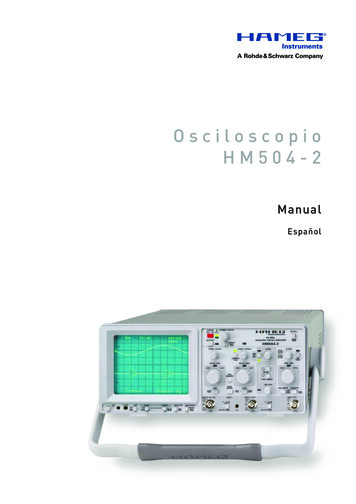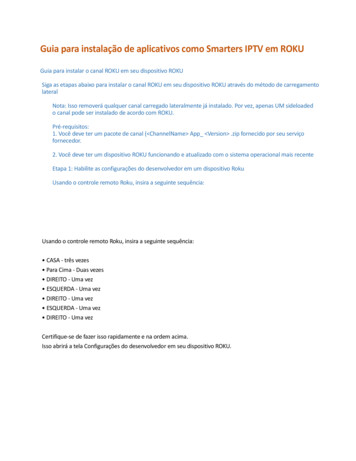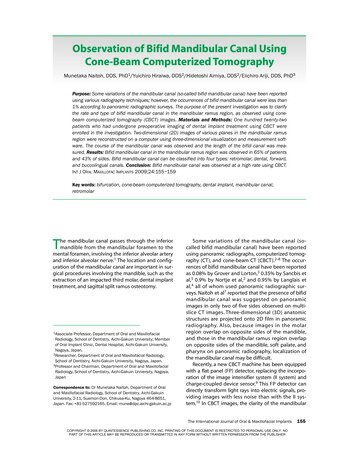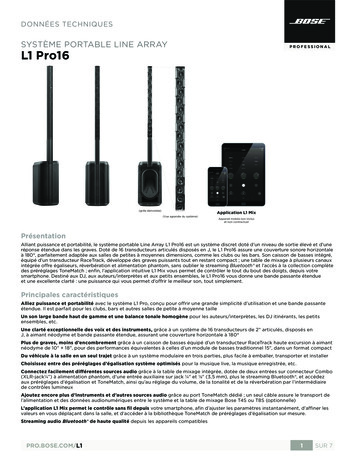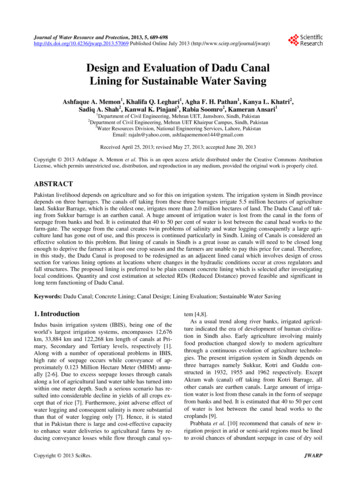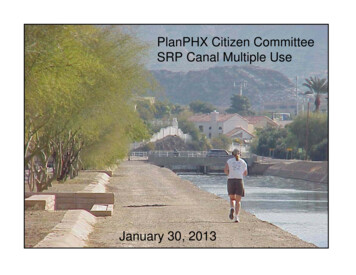
Transcription
The Boater’s HandbookBasic Boat Handling and Safety forPowered Boats and Unpowered CraftIf you have received thisbook from a hire boatoperator, please returnit after your holiday soit can be used again.In partnership withCharity no. 1146792PR #7335 CRT BoatersHandbook2021 am1 160721 v2.indd 121/07/2021 13:44
PrefaceSafety ChecklistAvoid slips and trips! Watch out for mooring ropes,bollards, holes and other hazards. Use grab rails. Wear non-slip shoes. Don’t try to jump fromthe boat onto the bank. Wear a life jacket.Watch out for fire and fumes! Don’t get crushed! A moving boat has the forceto crush you – keep yourbody out of the way. Don’t fend off with your arms,legs or a boat pole – let thefender take the impact. on’t have your legs dangling overDthe side, your hands over the edgeor your head out of the hatch. Keep off the roof when underway(low bridges could knock youoff the boat or worse).The bottled gas used for cookers,fridges and heaters is heavier thanair and, if there’s a leak, it will liein the bottom of the boat whereit only takes a spark to ignite.Watch out for fumes fromcookers, cabin heaters and waterheaters or from engine exhaustbuilding up in the boat. Carbonmonoxide poisoning is extremelydangerous – early signs includeheadaches, tiredness, sicknessand dizziness, and other flu-likesymptoms. Anyone affectedshould get medical help right away. Switch off appliances whenyou’re not using them. Keep ventilators open andfree of obstructions. If you smell exhaust, gas, or petrolfumes, raise the alert right away.Don’t rock the boat! hink carefully beforeTclimbing onto the cabin roofas the boat could becometop heavy and unstable. Don’t all stand togetheron the same side if it riskstipping the boat over.This booklet is the result of adetailed study of safe boating.The research was carried out bythe Canal & River Trust and theEnvironment Agency, with helpfrom British Marine and the Trust’sNavigation Advisory Group whichis made up of experienced boaters.As well as introducing the basics ofboat handling, it aims to help peoplespot risks and avoid accidents.Feel free to copy it. All we ask isthat you don’t alter our messages,pictograms or illustrations.We’ve tried to make the informationin the handbook applicable toinland waterways generally, butlocal conditions vary, especially ontidal waterways. So always seeklocal information if you’re planningto visit an area that’s new to you.We want the information in thehandbook to reach everyonewho goes boating on the inlandwaterways in a powered boator unpowered craft. A pdf versionis downloadable Introduction Who’s in charge? Before setting off – top tips 561 Boat Handling Setting off 8Under way 9Steering 10Going aground, Slowing downand stopping 11Mooring 12Tying up 14Locks 16Bridges 30Winter cruising 32Wide beam boats, Powered& Unpowered Craft 33Tunnels 34Unpowered craft in tunnels352 Boating Safety Accidents, Falls 36Fire, explosion and fumes 38Collisions 42Crushing 43Capsize, Man overboard 44Operating injuries 46Lock safety 47Fast-flowing water 48Strong stream conditions 49Vandalism and aggression,Waterborne diseases 52Training and guidance 53Carbon Monoxide54Unpowered craft55Stand up paddle boards (SUPBs)563 Rules of the Waterway Channel markers, Weirs, Overtaking,Giving way, Speed limits, Passing dredgers or works,Sound signals, Navigation lights 4 Good Boating Behaviour Water safety zones Caring for the environment What makes a good boater? 57585960625 Further Information First published Spring 2002. This revision Spring 2021.Cover photograph courtesy of the Environment Agency.2PR #7335 CRT BoatersHandbook2021 am1 160721 v2.indd 2-3Contacts 64Useful information, Signs 68Signs 69321/07/2021 13:44
IntroductionIntroductionWelcome toThe Boater’s HandbookThis handbook gives you all the boating basics – the essentialknowledge and techniques you need to make sure you enjoyyourselves and stay safe. Reading it before setting off willhelp you to spot the risks and take simple action to avoidproblems. If you do run into difficulties, this understandingshould help you get out of trouble quickly and safely.1Boat HandlingPart one takes you through thebasic skills for handling your boat.2 Boating SafetyPart two gives important safety rulesto help you keep out of trouble. It’svital stuff. So please – for your ownsafety – read through carefully.3 Rules of the WaterwayPart three gives you the basicrules of the waterway.4 Good Boating BehaviourPart four is all about respectingthe environment, the wildlifeand other waterways users.5 Further InformationPart five provides contact details forthe navigation authorities and listsother sources of useful information.4PR #7335 CRT BoatersHandbook2021 am1 160721 v2.indd 4-5The Boater’s Handbook is designedfor newcomers to boating, but wehope it will also be a handy reminderfor more experienced boaters.Read this handbook before you setoff, and keep it nearby for reference.Of course, you won’t become anexpert overnight just by reading abook – and it’s impossible to coverevery aspect of boating, every typeof boat and every eventuality. You’llfind pointers to sources of localwaterway information in part five.Short courses in boat and unpoweredcraft handling are an excellentinvestment. There are details on page 53.If you’re hiring your boat, theoperator will give you instructions.Pay close attention – and don’tcast off until you feel confident!Who’s in charge?One of the great things about boatingis that everyone can muck in together.But at least one person needs toknow the boat handling basics, tounderstand the safety guidelines andto know what to do in an emergency.navigation and so on. As well asknowing the procedures, your crewshould be aware of the safety risks ineach situation and how to avoid them.Someone should be competent totake over if the skipper becomes ill.So, once you’ve chosen a ‘skipper’,it’ll be their job to make sure yourcrew and passengers have all theinformation they need to staysafe. It’s a good idea to be clearon each crew member’s duties.Think very carefully beforegoing afloat alone as the risksare very much greater for youand other waterway users.Good boating takes teamwork. Soyou need competent crew who knowhow to handle the boat and how tostop the engine, and who can helpwith mooring, moving through locks,Passengers who aren’t going tobe helping with any of the workstill need to read and understandthe basic safety rules – so pleaseshow them the safety checklistat the front of this handbook.Learn from the advice of localnavigation staff, volunteers and otherboaters you may meet along the way.521/07/2021 13:44
IntroductionIntroductionBefore setting offBoat jargonFollow these simple tips for trouble-free boating. heck that your boat, engineCand fuel system are in goodcondition and meet Boat SafetyScheme requirements.See contact details on page 53 ake sure you and your crewMknow how to handle the boat– and have the skills for thewaterway you’re using et information on possibleGstoppages, stream conditions andtides and if you’re planning to goon unfamiliar waterways checkthat your boat will fit throughbridges and locks and that thewaterway will be deep enough.See contacts list on page 64. lan your cruise and allow enoughPtime to complete it withoutrushing. Add the number of locksto the number of miles and divideby 3 to get a rough idea of theminimum number of hours that ajourney will take – it could takelonger if there isn’t much depthor you need to wait to use locks I t’s not a good idea to cruise inthe dark or when visibility’s bad– if you have to, take extra care Make sure you’ve got enough waterand fuel on board for your trip Make sure you have a mobilephone handy and charged incase you need to use it in anemergency. Being able to makean emergency call could makeall the difference if you get intodifficulty, especially if tacklingsomething with increased risk suchas locking or river navigations.WarningStay safe on the water – don’tdrink and drown. – Every yearpeople die from drowning in the UKand alcohol is often a contributoryfactor. About a quarter of alldrowning victims have alcohol intheir bloodstream. Accidents dohappen whilst boating andunfortunately the chances of thingsgoing wrong increase significantlythe more you’ve had to drink.This is why drinking and boating atthe same time are the wrongingredients for a cocktail of fun.Enjoy your boating, just rememberto save your favourite tipple forafter you’ve moored up for the day.Boats come in different sizes,shapes and materials – and they allbehave differently. Before you setoff, spend some time getting toknow your boat.Right: StarboardFront: BowBack: SternLeft: PortSpecial safety tipsEquipment checklist – Make sure you know where to find these things: Lifebuoy, lifeline (if supplied),lifejackets or buoyancy aids Emergency torch nchor – for rivers and tidalAwaters, lochs and lakes – therope and chain together shouldbe at least six times as long asthe deepest part ooring ropes – long enoughMto stretch from your boat tothe bollard and back, evenwhen you’re in a deep lock Mooring stakes and hammerFire extinguisher(s)and fire blanket Horn First aid kit Emergency shut-offs forbattery, gas and fuel Boat pole or hook Gangplank Bilge pump Windlass – see page 22 Boat poleBoat hookLifebuoyTillerFenderFenderMooring ropeFendersMooring ropeSpecial safety tips6PR #7335 CRT BoatersHandbook2021 am1 160721 v2.indd 6-7721/07/2021 13:44
Start the engine, keep it in neutraland allow some time for it to warmup before you move off. Once thecrew are ready and the skipper hasgiven permission untie the front andback mooring ropes from the bank,but leave them tied to the boat, coiledand ready for use. On rivers, untie thedownstream rope first. Make sure yourropes can’t trail in the water and getcaught in the propeller. Don’t forget tostow the mooring stakes and hammer.Under wayBecause the boat steers from theback, you can’t drive away from thebank as in a car. Check the area isclear of boat traffic then push theboat away from the bank so youcan make a clean departure, withyour propeller in deep water. Inshallow water, push the back of theboat out, then reverse away untilthere’s room to straighten up.When the boat’s straight, go intoforward gear and accelerate gentlyto an appropriate cruising speed.WarningChecking for weed or debris around the prop?Turn the engine off and take the key out of the ignition. Removethe weed hatch and check the propeller. Take care when youremove any debris that is caught or wrapped around. It’s agood idea to wear thick gloves. Fasten the lid back securelyand, when you start off, look to check that it isn’t leaking.On all waterways, the rule of thewaterway is to be on the right. Onwide waterways this may be easy.But on most canals, unless there’sanother boat coming towards you,you’ll steer down the middle as it’slikely to be shallow near the edges.When you do meet an approachingboat, keep to the right and pass‘port-to-port’ (the left side ofyour boat passes the left sideof the approaching boat).Don’t cut the corner when goinground bends. You run the risk ofa collision or going aground.Read up on all the other rules ofthe waterways on page 57.We want everyone to be able toenjoy our waterways safely. Thismeans you need to be aware of otherusers and consider their needs.1 Boat Handling1 Boat HandlingSetting offGo slowly past boats, anglersand other waterway users.Don’t let your boat create a breakingwave or a lowering of the wateralong the bank just ahead of theboat. These are signs that you shouldthrottle back to prevent damageto the bank and disturbance tomoored boats. Excessive speedcan also dislodge mooring pins.Look out for swimmers, canoes,punts, rowing boats, sailing dinghiesand anglers. Remember theycannot always see or hear youapproaching. Slow down so thatyour boat isn’t creating a wave. Givethem plenty of room as you passby. Warn other boaters coming inthe opposite direction if you can.Be safe around other craft and waterway usersWatch out for other waterwayusers – canoes, other unpoweredboats or even swimmers.Some vessels, such as loadedcargo vessels requiring deep wateror vessels proceeding with thetide or stream, may have to pass‘starboard to starboard’. Such avessel will indicate their intentionby two short blasts to signify that8PR #7335 CRT BoatersHandbook2021 am1 160721 v2.indd 8-9they will be altering their courseto port. In such circumstances itis necessary to reply with a similarsignal and to take similar action.A vessel meeting or overtakinganother vessel being towed fromthe bank should always passoutside the towed vessel andnever between it and the bank.921/07/2021 13:44
Going agroundSteering a boat with a wheel is likesteering a car, but it’s more difficultto judge where your wheel shouldbe for going straight ahead. Get toknow the feel of the wheel and therudder position before you set off.Using a tiller to steer is simple– as long as you remember thatpushing to the right will make theboat head left and vice versa. Bepatient and plan ahead – the boatwill take a few seconds to respond.PivotpointRudderpositionMost boats pivot from a point abouthalfway along their length. Thatmeans you need to watch out forthe front and the back. If you lineup the front only and then try toturn into a narrow gap – a bridge orlock, for example – you risk hittingthe side with the back of your boat.Watch out for currents or crosswinds pushing you off-course too.PivotpointRudderpositionEveryone goes aground at somepoint – it’s not a disaster.Don’t try to force your way over theobstacle or you’ll find yourself evenmore stuck. Instead, use reverse gearto back away into deeper water.If you’re firmly stuck, ask some or all ofthe crew to move to the side or backof the boat that’s still floating – but notto the extent that you’d risk capsizing!Now use the pole to push off againsta solid object or the bed of thewaterway – if you put the pole straightdown and try to use it as a lever, it’lleither break or you’ll fall in. Keep thetop of the pole away from your faceand body, in case it slips suddenly.PivotpointRudderpositionSlowing downand stopping1 Boat Handling1 Boat HandlingSteeringBecause boats don’t have brakes,you need to give yourself plentyof time to stop – especially whentravelling downstream on flowingwaters. Ease off the throttle, moveinto neutral and then use reversegear to slow down and come to afinal halt. Opening the throttle togive more engine revs will increasethe braking effect when in reverse.Remember that it’s extremely difficultto steer when you’re in reversegear. You may need an occasionalforward boost to get better control.Special safety tips lways be aware of what’s happening around you – on the boat, in theAwater and on the banks hink ahead and make sure you’re lined up for bridge and lockTentrances well in advance n a traditional or semi-trad narrowboat, stand in front of the small rearOdeck and not beside the tiller so you won’t fall off when making sharpturns or going into reverse. Don’t let passengers stand or sit in the wayof the tillerWarningYou can’t steer unless your boat is in gear.Remember – in gear and under way (no gear, no steer).10PR #7335 CRT BoatersHandbook2021 am1 160721 v2.indd 10-111121/07/2021 13:44
Prepare your crew in advance. Makesure they know what their jobs will be.Slow down almost to a stop andcarry out all your manoeuvresas slowly as possible.Stop short of where you want to moorwith your boat straight and in deepwater. Move forward very slowly,pointing the front of the boat towardsthe bank, then use reverse to stopthe boat just before the front hits thebank. Put the engine into neutral.Your crew should step ashore – notjump. They can either carry the ropeswith them – making sure there’splenty of slack and that one end isfixed to the boat – or you can passthem the ropes once they’re on land.On rivers you should moor with thefront of your boat facing into thestream. This gives you more control asyou slow to a halt. So, if you’re headingdownstream, you’ll need to pass themooring and turn your boat around.The same applies if you have a verystrong wind behind you. It is easierto go past the mooring and turn yourboat around so that you moor intothe wind. Allow for the fact that thewater level may rise or fall by severalfeet. If it’s a tidal river, you shouldalways moor facing the tide – andavoid mooring to the bank overnight.Downstream ReachCan I moor here?Don’t moorIt’s usually best to moor against thetowpath or on signed visitor moorings.Many riverbanks and the non-towpathside of canals are private property. I n locks, lock approachesor in lock flights locking taps and other servicesBunless you are using them Near any bridges Under fixed bridges Near weirs Near sharp bends On the outside of bends By blind spots In or opposite turning points/winding holes or on theapproach to these At junctions o the bank on a tidal river – youTmight find yourself hanging fromthe ropes when the tide goes out! n landing places forOcanoes– usually near locks I n stretches marked outfor an angling match here there are signsWthat prohibit mooringCheck that you’re not a hazardto other boats or to people usingthe bank. At busy sites positionyour boat to leave room for otherboats to tie up too. You could evenencourage another boat to tie upalongside you providing it wouldn’tinterfere with boats passing by.Respect any time limits. On Canal& River Trust waters, if there is nosign you are generally allowed tomoor for up to 14 days. You may becharged for staying longer. Somemoorings, particularly on rivers,charge from the day of your arrival.On other waterways mooring staytimes vary, please check signage.If moorings are signed for disabledboaters, please give priority tothose who need to use them.Swing Bridge1 Boat Handling1 Boat HandlingMooringFixed River BridgeWinding Hole –Turning PointLift BridgeTunnel PortalNarrow CanalLock FlightFixed CanalBridgeWeir streamLockPoundIslandBoomWeir12PR #7335 CRT BoatersHandbook2021 am1 160721 v2.indd 12-13Canal JunctionServicesRiver Flow1321/07/2021 13:44
To keep your boat secure, you need totie it to the bank with a rope from boththe front and the back. On rivers, youshould fix your upstream rope first.Many mooring sites have bollards orrings to tie up to – choose ones ashort distance beyond the front andthe back of your boat. Run your ropesat about 45º from your boat, loopthem back onto the boat and tiesecurely, but not too taut.To stop your boat moving backwardsand forwards in flowing water, you canuse extra ropes as ‘springs’ – seeexample below.1 Boat Handling1 Boat HandlingTying upUseful knotsIf there aren’t any bollards or rings,use your mooring stakes if the groundis suitable. Do not attempt to hammerinto concrete or other hard surfaces.If the ground is soft, check thestability of the bank and watch out forsigns of underground pipes or cablesbefore you start hammering. Positionthe stakes as far from the bank as youcan, but don’t tie your ropes acrossthe towpath. Knock them in to aboutthree-quarters their length and makesure they’re firm. Mark them with apiece of light-coloured cloth or a whiteplastic bag or bottle so that othertowpath users can see them clearly.Leave some slack in your ropes –this is especially important on tidalwaterways or rivers. If the ropes aretoo tight and the water level drops,your boat could be left hangingfrom the bank.Remember that your anchor can beused if you need added security orextra help in a strong stream ortide – and you should still usemooring ropes.Special safety tipsLocking hitchRound turn and two half hitchesQuick release clove hitchCanalman’s hitchBowlineMake sure you know how to use your ropes properly.Keep them coiled, free of knots – and don’t drop them in the water,especially near a propeller. A rope can easily get wrapped aroundthe propeller which will stall the engine and leave you with no wayto control the boat.14PR #7335 CRT BoatersHandbook2021 am1 160721 v2.indd 14-15It’s worth learning more about these and other knots. See links on page 68.1521/07/2021 13:44
There’s no mystery to using locks– just a series of step-by-steptasks. Understand the procedure,take your time and you’ll be onyour way with no problem.A lock is simply a chamber withgates at either end. By emptying orfilling that chamber with water, yourboat can move up or down ontoa new section of the waterway.Although there are many differentkinds of locks, they all work on theFeatures of a typical narrow canal locksame basic principle. With the lockgates closed, you open sluices orpaddles to let the water in or out.When the water level under yourboat is the same as the level you’removing to, you’ll be able to open thegates to move in or out of the lock.Some locks you operate yourself andothers are operated by lock-keepers.Check your particular waterway fordetails. Always obey specific lockinstructions and local information.1 Boat Handling1 Boat HandlingLocksTypical cill warning signon balance beamKeep boatforward ofcill markerTop gateGround paddleGate paddleTop gate balance beamCill markerCillSpecial safety tips Take your time – and keepan eye out for problemsEnsure that you use a taperedeye of the windlass on a taperedspindle, never the square eyeEnter and leave slowly so bumpsare less likely to cause damageAlways have a competentperson on board whilethe boat’s in the lockKeep the stern of the boat clearof the cill when going downhillWhen going uphill, be careful notto get the rudder caught betweenthe gates or to get caught onany projections on the lock wallBoats tend to bang aboutwhen water flows in andout of a lock – stay alert Make sure that you raise yourside fenders when going throughlocks, particularly narrow locksWatch out for slipperysurfaces when you’repushing the gates open16PR #7335 CRT BoatersHandbook2021 am1 160721 v2.indd 16-17Ladder ork out some clear signalsWso that the crew and skippercan communicate quickly – asignal that means ‘close allthe paddles,’ for example Wait for the boat already in thelock to leave before you startopening or closing paddles Watch out for unprotecteddrops around the lockside,especially when opening gates If there is a bridge, use it whencrossing the lock. If not, takecare using the walking boardattached to the gates – do notjump across part-opened gatesAsk before helping other boaterswith their lock operationDon’t use a lock when it’sdischarging flood water (this onlyapplies on some river locks)Never jump from the boatonto the lock side or layby,step off carefullyAlways bring powered boats to astandstill using the engine, not bytrying to stop it using the ropesSluiceLock chamberBollardGate paddleSpindleBottom gatesBottom poundGate paddle1721/07/2021 13:44
As you approach the lock, drop acrew member off to check whetherit’s full of water or empty. If it’sempty, they can open the gates andyou can steer the boat straight in.If it’s full, moor up below the lock, farenough away to avoid the currentswhile the lock is emptying.If it’s full your crew must look to see ifthere is a boat already waiting to comedown the lock or one is approaching.Let them use the lock first. This willsave water. When they leave, thelock will be ready for you to go in.If there’s no boat in sight checkthat the paddles at the top of thelock are fully closed down, thenempty the lock by slowly raisingopen the bottom gate paddles.Open the gates and steer in.Close the gates and the paddles (orcheck that these are already downif the lock was ready for you).If there are ground paddles by thetop gate, open these first. Wait untilthe lock is half full before openingthe gate paddles. If there are onlygate paddles, open them very slowly,and a little at a time, especially if thepaddles are above the low water level.In wide and river locks keep your boatsteady using front and back ropeslooped round the bollards – take anextra turn around the bollard to stopthe boat pulling you, but don’t tie up.When the lock is full, open the gatesand move your boat out. Lowerthe paddles – and close the gatesbehind you unless a boat comingtowards you wants to use the lock.In narrow canal locks many boatersprefer to use the engine to controlthe boat. If the top gate has asmooth rubbing board you can keepa steel boat steady by using yourengine to push very gently againstit as the water level rises. Othersprefer to control the boat withropes looped round the bollards.If the gates don’t open orclose easily, wait till the waterlevel’s absolutely equal.1 Boat Handling1 Boat HandlingGoing upIf the gates don’t open fully, closethem and look for trapped debris,removing it with your boat-hook.WarningThis is what can happen if you open the gate paddles too soon.If this starts to happen, close the paddle(s).Ground paddleGate paddleWarning18PR #7335 CRT BoatersHandbook2021 am1 160721 v2.indd 18-191921/07/2021 13:44
As you approach the lock, drop a crewmember off to check whether it’sfull of water or empty. If it’s alreadyfull they can open the gates and youcan steer the boat straight in. If it’snot, moor up while it’s prepared.Open the paddles in front of the boat(at the bottom gate) to empty thelock, using your engine or ropes tokeep the boat as still as possible. Useropes to keep your boat parallel tothe lock side in wide and river locks.If the lock is empty, your crewmust look to see if there is a boatalready waiting to go up the lockor one is approaching. Let themuse the lock first. This will savewater. When they leave, the lockwill be ready for you to go in.When the water levels are equal, openthe bottom gates and take the boatout. Close the gates and lower thepaddles before you move on, unlessa boat coming from the oppositedirection wants to use the lock.1 Boat Handling1 Boat HandlingGoing downIf the lock is empty and no boat is insight, check that the bottom gatesand paddles are closed and then fillthe lock by opening the paddles at theend nearest to your boat. When thelock’s full, open the gate and steer in.Close the gates and lower the paddles.WarningKeep the back of your boat well forward of the cill below the top gates.Cills stick out by up to 5ft (1.5m) and you can only see them as the lockempties. Most locks have markers to show you the approximate position ofthe cill. If you are not alert, it’s easy to get the back of the boat ‘hung up’ onthe cill. If the boat starts to tilt like this, close all paddles immediately.See instructions on refilling locks on p22.Cill20PR #7335 CRT BoatersHandbook2021 am1 160721 v2.indd 20-21WarningIf someone falls into the lock, act quickly.If there’s no lock-keeper to take charge: Close all the paddles Throw a lifeline or lifebuoy Stop the engine andkeep the boat still I f there’s no ladder – or theperson can’t climb – you mayneed to fill the lock slowly tobring them up to your level. Or, ifthe lock is almost empty, slowlylower the water level, open thegate and draw the person tosafety using the lifeline or a rope NEVER jump into thewater yourself to rescuesomeone who has fallen in2121/07/2021 13:44
1 Boat HandlingWarningFloating freely?As the water level rises or falls,keep a constant eye on your boatto check that it’s floating freely. If it does get caught or jammed,immediately close all the paddlesand work out what needs to bedone to get it level again. oing down – If the side ofGyour boat is caught against thelock wall or the back is caughton the cill close the bottomgate paddles to stop the waterfalling further. Slowly openthe top gate paddles to refillthe lock. Check for damage.If your ropes get snarled ortoo tight to let your boat movedown freely slacken them off ifyou can. If not, refill the lock. oing up – If the front of yourGboat is caught under part ofthe top gate or your rudder istrapped between the bottomgates, close the top paddlesto stop the lock filling. Openthe bottom gate paddles toallow the water level to fall.If you’re sharing the lock withanother boat, make sure there’sa safe distance between you.Use ropes looped round thebollards to keep you in position.Upstream (top) paddles fill the lock.Downstream (bottom) ones empty it.Paddle gear can be either hydraulicor rack and pinion. On the rack andpinion type, remember to engagethe safety catch before winding upthe paddles. This stops the gearsfrom slipping down. When you’vefinished winding the paddles up,check the safety catch is in positionand then take off your windlass.With one crew member at the helmand one at the paddles, you windthe paddle gear up and down using1 Boat HandlingWorking the paddle gearBoat in the locka windlass or lock key. You shouldalways wind them bit-by-bit – andkeep an eye on the effect of themoving water on your boat.To close the paddle, take theweight on your windlass, then liftoff the safety catch and wind thepaddle down – if you let it drop,the spinning windlass could injureyou, especially if it flies off.Paddle gear that it is enclosed oftenhas an indicator to show how farit is open (up) or closed (down).Rack and pinionpaddle gearSafety catchWindlass slotted fullyonto the spindleSpecial safety tips I f you use ropes to keep theboat steady in the lock, don’t tryto take the full strain of the boatdirectly with the rope – wind itonce around the bollard ake special care not to let yourTfingers get between the ropeand the bollardSpecial safety tips A flying windlass can cause serious injury! To avoid an accidental launch:– Keep a firm grip and don’t let go– Only use a windlass that fits the spindle snuglyDouble windlassSpindle types– Make sure the windlass is fully slotted onto the spindle– Always use the safety catch when winding paddles up– Never leave the windlass on the spindle unattendedParallel type(Hydraulic gear)22PR #7335 CRT BoatersHandbook2021 am1 160721 v2.indd 22-23Tapered type(Mechanical gear) Keep fingers, hair and clothing away
book - and it's impossible to cover every aspect of boating, every type of boat and every eventuality. You'll find pointers to sources of local waterway information in part five. Short courses in boat and unpowered craft handling are an excellent investment. There are details on page 53. If you're hiring your boat, the


